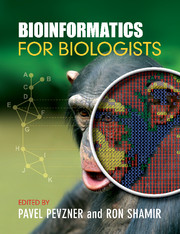Book contents
- Frontmatter
- Contents
- Extended contents
- Preface
- Acknowledgments
- Editors and contributors
- A computational micro primer
- PART I Genomes
- PART II Gene Transcription and Regulation
- 6 How do replication and transcription change genomes?
- 7 Modeling regulatory motifs
- 8 How does the influenza virus jump from animals to humans?
- PART III Evolution
- PART IV Phylogeny
- PART V Regulatory Networks
- REFERENCES
- Glossary
- Index
7 - Modeling regulatory motifs
from PART II - Gene Transcription and Regulation
Published online by Cambridge University Press: 05 June 2012
- Frontmatter
- Contents
- Extended contents
- Preface
- Acknowledgments
- Editors and contributors
- A computational micro primer
- PART I Genomes
- PART II Gene Transcription and Regulation
- 6 How do replication and transcription change genomes?
- 7 Modeling regulatory motifs
- 8 How does the influenza virus jump from animals to humans?
- PART III Evolution
- PART IV Phylogeny
- PART V Regulatory Networks
- REFERENCES
- Glossary
- Index
Summary
Biological processes are mediated by specific interactions between cellular molecules (DNA, RNA, proteins, etc.). The molecular identification mark, or signature, required for precise and specific interactions between various biomolecules is not always clear, a comprehensive knowledge of which is critical not only for a mechanistic understanding of these interactions but also for therapeutic interventions of these processes. The biological problem we will address here, stated in general terms, is: how do biomolecules accurately identify their binding partners in an extremely crowded cellular environment? An important class of cellular interactions concerns the recognition of specific DNA sites by various DNA binding proteins, e.g. transcription factors (TF). Precisely how the TFs recognize their DNA binding sites with high fidelity is an active area of research. While a detailed treatment of this question covers several areas of investigation, we will focus on aspects of the TF–DNA recognition signal that is encoded in the DNA binding site itself. In this chapter we will summarize a number of approaches to model DNA sequence signatures recognized by transcription factor proteins.
Introduction
Most biological processes critically depend on specific interactions between biomolecules. A key question in biology is how, in the overly crowded cellular environment, these various interactions are accompished with high fidelity. Evidence suggests highly developed mechanisms for trafficking, addressing, and recognizing biomolecules within a cell. For instance, brewer's yeast (Saccharomyces cerevisiae) feeds on galactose, among other sugars.
- Type
- Chapter
- Information
- Bioinformatics for Biologists , pp. 126 - 147Publisher: Cambridge University PressPrint publication year: 2011

